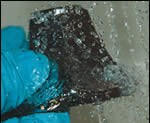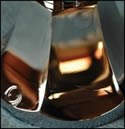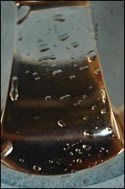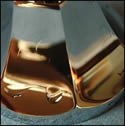How Clean is Clean?
How to find out if your parts are clean enough
How clean is clean enough? This is a perennial question and one that is being readdressed with renewed urgency given cost, performance and supply chain issues. Knowing the best answer for your parts is critical to quality and to the survival of your business.
Many companies are bringing processes—including parts cleaning—in-house in response to inconsistent quality and inadequate documentation on the part of their sub-contractors. These manufacturers are then faced with addressing the problem of how clean their product needs to be. In the process, the skills and knowledge that smaller, specialized, experienced sub-contractors bring to the table may be lost.
In large plants, bringing the cleaning process in-house may only serve to create in-house supply chain problems. The manager of one process may not communicate cleaning requirements to those performing the upstream process.
On the other hand, if you are a small, specialized job shop, understanding the cleaning requirements of your key customers can improve real and perceived quality and put you at a competitive edge.
Just as it is important to identify why you are cleaning your parts, it is also critical to understand why you would perform a test for contamination. Unneeded testing diverts money and engineering resources that could be spent to grow the company.
Part of “why” includes identifying the customer and the end-use of the product. In coating or plating operations, assuring good adherence and minimizing surface defects are crucial. This may mean minimizing organic residue or assuring that particles are below a certain level.
One thing it should mean is focusing on reducing surface contaminants to zero. Elimination of contamination from the product is a common goal of process improvement efforts. The goal of zero contamination may be an edict from corporate management or a statement from a key customer, or maybe you yourself fantasize about ridding your product of all contamination.
Forget about achieving zero residue; it is an impossible goal. Instead, redirect your efforts to determine how clean your product needs to be for the application at hand. Invest in finding the most effective ways to minimize contaminants on the product and to minimize sources of contamination.
Acceptable levels of residue or contamination are set by a variety of factors, including customer requirements, industry-wide standards, benchmarking of historically acceptable product and customary practice or habit.
Measuring cleanliness, or measuring residue, involves identifying and sometimes quantifying contamination. Contaminants may be thin films or particles; organic (such as oils or greases) or inorganic (salts); and they may be dead or alive.
This article reviews multiple techniques for evaluating the cleanliness of surfaces. It also discusses some of the specific surface cleanliness standards used for specific applications, such as in implantable medical devices.
Visual Techniques
One common way to evaluate surface cleanliness is with a visual check. Some sub-contractors depend on visual observation alone. They “know” the part is clean by looking at it themselves or by depending on their most experienced technicians.
Visual observation cannot and should not be ignored. Measuring cleanliness involves observation, and it is usually impractical to monitor every single part. Therefore, your first line of defense is observation of the product by experienced employees. Such observation will not tell you what a contaminant is, but you will gain information that something is wrong, that the surface is not what it ought to be. Examples of this technique include visual observation, observation under magnification, looking at the product under an ultraviolet light (black light), white glove testing and the water drop test.
However, knowing cleanliness when you see it is not the same as demonstrating and documenting cleanliness for customers. This back-up documentation is especially important when you or your lead technician are out of the plant.
A commonly used visual technique for evaluating surface cleanliness is water-break testing, which can be useful for monitoring ongoing processes if you understand its limitations. A colleague illustrates the water-break, or its more sophisticated cousin contact angle measurement, by noting that water beads up on a highly polished automobile because there is residue (wax) on the surface.
This beading of water represents a high contact angle or an unacceptable water-break test. To verify lower residue, the water should “spread out” on the surface; this represents a more desirable, cleaner, lower contact angle. Of course, in the case of the newly detailed car, the wax represents a desirable “contaminant” or attribute of the surface.
Contact angle can be estimated visually; such estimates are very dependent on the observer. There are also automated instruments—goniometer systems—for contact angle measurement. Many systems measure and record the contact angle in a very reproducible manner and store the information for future retrieval.
Water-break testing and goniometry have several limitations. For one thing, the flat surfaces may be free of residue, but interfering soils may lurk in blind holes and other features. Very fine (sub-micron) particles can interfere with the estimates. Inadequately rinsed parts may appear to be very clean, because cleaning agent residue reduces the observed contact angle, masking surface contamination. In addition, cleaning agent residue can itself interfere with downstream processes such as plating, painting or powder coating.
Microscopy
Many groups and individuals involved in the cleaning industry are accustomed to using scanning electron microscopy (SEM) and energy-dispersive X-ray analysis (EDX) as the be-all and end-all of surface monitoring. SEM gives you a high-resolution, high-magnification picture of the surface that sometimes enables you see surface defects and
particles; EDX identifies elements or atoms.
With SEM/EDX, you can identify metallic particles and other inorganic contaminants. However, most metalworking fluids and cleaning agents contain both inorganic and organic materials, and very often, the interfering contaminant is an organic compound. In fact, many of the currently favored (from an environmental perspective, at least) bio-based metalworking fluids contain very high-boiling materials. Those materials can adhere to surfaces, often as thin films.
EDX typically will not allow identification of carbon-based contamination from bio-based and other process materials. In addition, the contamination may be concentrated in the nooks and crannies of the parts; you may not pick up the contamination using SEM/EDX or any other surface technique.
Particles and Residue
Tracking the residue weight on a specific part and determining the particle level can provide information about changes in your manufacturing process or an impending contamination problem.
Counting particles and determining the amount of non-volatile residue (NVR) on a part sounds deceptively simple and standardized. Based on my experience, the techniques are much more complex than would be expected. You need an experienced analyst with the time, patience, skills and understanding of the potential residues of concern to perform the test consistently and according to any required specification. You also need an analyst with the common sense to look at historical data and report any unexpected changes or observations.
Many groups try to estimate residue by weighing the part before and after cleaning. This technique is usually rather uninformative, because for most applications the weight of the part before and after cleaning is very similar. The variability inherent in any measurement, including weighing, makes it difficult to get a meaningful answer. This approach has been likened to attempting to determine the weight of the captain of a ship by weighing the ship with and without the captain. If there is a detectable difference in the weight, the captain is severely obese and the parts were probably exceedingly soiled and still need additional cleaning.
A more informative approach is to extract the residue from the part using water or an organic solvent with a suitable extraction technique, concentrate and then evaporating the residue onto a suitable pre-weighed dish, and then weighing the residue. This is sometimes referred to as the non-volatile residue (NVR).
Many methods call for filtering the extraction liquid before weighing, then counting, and sometimes sizing the particles trapped in the filter. In other instances, the particles are determined in the liquid either visually or using an automated particle counter.
An additional complication is what extraction fluid to use. Choosing water because you use water-soluble coolants and lubricants may lead to a false sense of security. As we have pointed out, water-soluble lubricants can chemically change during processing, making them difficult to remove and trapping particles and other debris on the part. You may need a more aggressive solvent to extract successfully.
Then there’s the issue of visual versus automated particle counting. Both methods have advantages. Automated methods tend to be more consistent and less operator-dependent than visual methods, especially if you correct for air bubbles that might be counted as particles. Visual methods are less costly in terms of capital investment. Also, with visual methods, you can sometimes gain insight into the nature of particle from its appearance.
Specialized Testing
Identifying contaminants or determining that contaminants are not present above a certain level may require analytical testing. SEM/EDX may provide information that there is carbon or iron or silicone in a residue, but it will not indicate the specific molecule. Lots of molecules contain carbon; some may be more of a problem than others. Analytical testing allows identification of specific molecules and tells you the quantities of those molecules present.
I have a background in analytical chemistry, so I respect the value of analytical tests to solve process problems and to reduce failure. But too often I see analytical testing used ineffectively and for incorrect purposes. I suggest using analytical techniques judiciously, as part of overall programs for process validation and monitoring.
In other words, blindly sending a sample off to the lab is not the answer. First identify the likely contaminants and undesirable residue on your part, then select the best technique for your purposes.
Selecting the best specific analytical technique requires a bit of research. On televised forensic crime dramas, they perform gas chromatography/mass spectroscopy (GC/MS) on a sample and, before the next commercial, the poison is positively identified and the culprit taken into custody.
Things just don’t work that way in real life. There are many variables involved in performing GC/MS and in collecting and preparing the sample. Interview labs and lab personnel, and then select carefully. Interpret the results carefully. If in doubt, ask the lab analyst for help.
Useful Standards
There is no single standard that tells us how clean is clean enough, but you should investigate standards that are important to your most critical applications and customers. If in doubt, ask your customer about required standards.
One particularly important cleanliness standard, particularly for aerospace manufacturers, is IEST-STD-CC1246, “Product Cleanliness Levels and Contamination Control Program.” Derived from MIL-STD-1246, the document does not contain cleaning recipes or specific extraction techniques. Rather, it provides definitions, and among the definitions are categories of cleanliness levels of surfaces in terms of the number of allowed particles of a given size and NVR in terms of the mass or residue per unit area of surface.
Therefore, you do not “conform to” CC1246; instead, you achieve a certain category within the standard in terms of particles and NVR.
Your current customers may not require meeting a particular cleanliness level. However, to achieve greater cleaning process reliability and to appeal to a more lucrative customer base, it may be desirable to use CC1246 to set standards within your shop. Use the standard, but also keep in-house records of the exact processes and protocols used to meet the standard.
Also be aware that CC1246 does not address specific contaminants, so know your customer and your process requirements. Depending on the process, it may be necessary to eliminate silicones, phthalates (plasticizers), and phosphates from your production processes.
A widely recognized standard in the medical device manufacturing industry is ISO 10993-17, “Biological Evaluation of Medical Devices — Part 17: Establishment of Allowable Limits for Leachable Substances.” If you produce components that will be used in implantable medical devices, it is a wise move to understand this useful normative document.
As the title suggests, the standard provides approaches to setting allowable levels of leachable substances on implantable parts. This includes residues from processing, fabrication and cleaning. The purpose of the standard is to manage leachable substances from devices through identification, quantify associated risks and limit exposure within tolerable levels.
ISO 10993-17 can be used to develop and validate cleaning processes. Medical device companies doing the final assembly may set the allowable levels, but if you are a supplier to such companies it is important to minimize potentially toxic leachable residues and avoid process changes.
Clean Enough?
So, are your parts clean enough? There is no absolute answer to our original question. You must decide, based on requirements for your product. As a sub-contractor, understanding, documenting and communicating how clean is clean enough are important steps in maintaining and growing your business. As a final assembler, defining and justifying cleaning requirements and surface contamination levels makes the difference between product success and failure.
Ultimately, if the product works reliably for the intended purpose, it is clean enough. However, products change and the end-use requirements for those products change. “Clean enough” for today’s applications may not be adequate to meet changing requirements.
“Clean enough” for tomorrow is a judgment call backed up by lessons learned from failures, industry standards, process control, surface testing and analytical testing for process validation and process monitoring, and past performance of similar products. Certifications, lab tests, and monitoring all provide support if and only if you understand the significance of the testing.
Read Next
Delivering Increased Benefits to Greenhouse Films
Baystar's Borstar technology is helping customers deliver better, more reliable production methods to greenhouse agriculture.
Read MoreEpisode 45: An Interview with Chandler Mancuso, MacDermid Envio Solutions
Chandler Mancuso, technical director with MacDermid Envio discusses updating your wastewater treatment system and implementing materials recycling solutions to increase efficiencies, control costs and reduce environmental impact.
Read MoreA ‘Clean’ Agenda Offers Unique Presentations in Chicago
The 2024 Parts Cleaning Conference, co-located with the International Manufacturing Technology Show, includes presentations by several speakers who are new to the conference and topics that have not been covered in past editions of this event.
Read More

















.jpg;maxWidth=300;quality=90)









